Scars are the normal result of tissue repair in mammals. Scientists think that evolutionary speaking a scar and a faster healing process was more successful than a complete regeneration of skin that has all the same properties as before it was injured. Scientists know that this level of regeneration is possible because early mammalian embryos can heal without scarring. However, the process is more time-consuming which would allow for dirt and bacteria to more easily enter a wound making survival from wounds less likely.
Although usually harmless some scars can cause physical discomfort such as itching, and moderate pain with others causing more acute and even disfiguring and disabling effects. Scars can also cause psychological and psychosocial problems for people including lowered self-esteem, depression, relationship difficulties, and work-related problems.
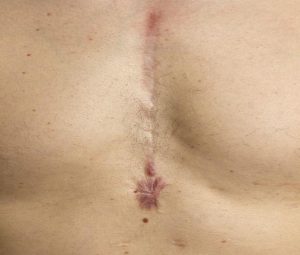
The type and appearance of scars can be affected by a variety of factors including the cause, the place on the body, age, genetic makeup, and nutrition can all, among other things, affect how wounds heal and therefore the formation of scars.
Types of Scar
Fine Line Scars

Fine line or so-called ‘normal’ scars are usually white. They are not painful, raised, or beyond the boundaries of the original wound. They fade with time but, as with all scars, are permanent.
Stretch Marks

Often a result of pregnancy these striae are formed by fast growth which causes damage to the dermal and subcutaneous skin layers but without the normal wound or other breach or the epidermis which usually causes scars. Initially appearing angry, red, purple, or pink stretch marks usually fade to light brown, silver, or white over time. Some over-the-counter creams and oils may have some benefit in reducing their severity when used before fast growth i.e. before and during pregnancy and their appearance once they have appeared but they do not disappear completely nor can they be avoided.
Widespread (stretched) Scars

Usually, as a result of surgical procedures, these scars widen and stretch usually in the month following the surgery. They are flat, white, and often shiny.
Scar Contractures
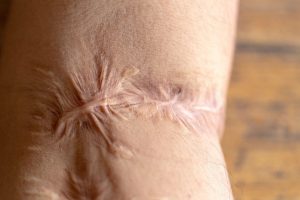
This type of scarring is often a result of burns particularly around joints or natural concavities on the body. They occur when the skin shrinks or shortens over the wound or burns and as a result, can cause reduced movement and disability.
Keloid Scar
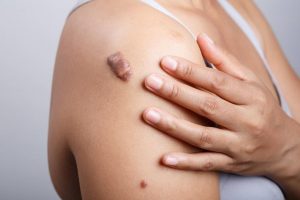
Sometimes the healing process creates a hard, smooth growth, which sticks out further than the wound did. This is called a keloid scar. It is unknown why keloids occur but they are caused by excess collagen. One person can only have one or multiple keloids, and some people never have them. They are more common in people with darker skin, again it is unknown why this is the case. Keloids are harmless, the growths are not related to cancer. However, they can be itchy or uncomfortable and due to the way they extend from the body clothing can rub making them sore. Keloids can form from any injury, wound, insect bite, burns, or acne though injection site keloids are thought to be more common. Keloids may continue to grow for just weeks or years and are permanent. It is possible to remove keloids with surgery however there is a risk that the keloid scar will return. Other treatments such as laser treatment, cryotherapy (freezing), steroid injections, and silicone treatments with gel or sheets can help to shrink or flatten the keloid but are not always successful.
Hypertrophic Scar
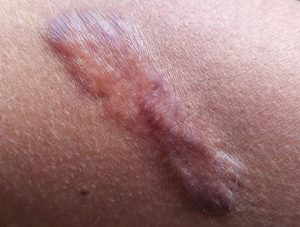
Similarly to keloid scars, hypertrophic scars are caused by excess collagen at a wound site. However, unlike keloids, they do not extend beyond the wound. Hypertrophic scars can be sore and itchy but do not cause or are a symptom of other health problems such as cancer. They usually start red and will stay red and continue to grow for up to 6 months. Usually, after this time they will begin to shrink and fade even without any treatment. Corticosteroid injections can help to flatten and calm hypertrophic scars quicker. Lazer treatment, surgery, silicone gels or patches, application of pressure, and massage are all treatments for this type of scarring with varying results. There are also mixed opinions about home treatment and creams and oils that can be bought over the counter with some people reporting excellent results. Limited clinical trials have so far been inconclusive.
Acne Scarring
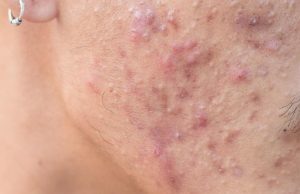
A common result of those who experience acne is scarring. This can come in several different guises.
- Post-inflammatory color changes – these can be dark, red, white, or purple
- Ice-pick scars –deep, narrow, pitted scars
- Rolling scars – broad depressions with a sloping edge
- Boxcar scars – broad depressions with sharply defined edges
- Atrophic scars –depressed scars like small, round holes
- Hypertrophic or keloid scars – thick lumpy scars.
-
Atrophic Scars
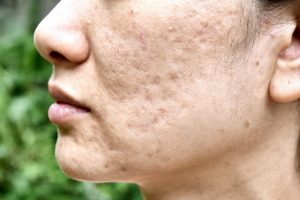
Often round, as their cause is commonly spots, acne, insect bites, or chickenpox, atrophic scars are indented, that is they are lower than the surrounding skin and small.
Surgical Scars

Depending on the type of surgery, the size and depth of the scar as well as if it is sutured or ‘glued’ closed will affect the time a surgical wound takes to heal and the appearance of the scar once it has healed. Generally speaking, surgical wound healing is expected to take around 6-12 months.
Scar Prevention
To minimize the risk or severity of scarring seek medical attention quickly for burns, large or deep cuts, skin conditions such as acne, or suspected infections. Prompt attention including wound care, antibiotics, stitching, appropriate dressings, and/or medications either topical or in some cases internal can help to minimize the likelihood or severity of scarring.
Good nutrition and hydration are also key to minimize scarring as the body will have everything it needs to heal as well as it can. Foods that can help to prevent, minimize and heal scars include protein rich foods to promote healing and foods rich in vitamin A, C and E to support the body and the skins immune systems and help eliminate free-radicals.
There are currently trials taking place following research and scientific study on embryonic healing among other things. These trials involve drugs that may be used to prevent scarring and include the altering of proteins such as cytokines which play a part in regulatory growth factors and immunomodulation. This is the future of scar prevention.
Treatment Options for Scars
- Laser treatment – the treatment of scarring using a single beam of light can either be ablative or non-ablative, the difference being ablative lasers remove material on the skin such as dead skin cells. Non-ablative lasers are not as hot which means they do not remove material instead it is like a controlled damaging of the skin to promote healing. This form of treatment helps to stimulate the skin’s natural healing processes and can even skin tone and improve smoothness leading to a reduction in the appearance of scars. Laser treatment is a fairly common and effective method of managing acne scarring.
- IPL – intense pulsed light treatment has been proved to improve the appearance of a variety of scars including burns, acne, trauma, and keloids. In one study over half the people who tried this form of light treatment reported excellent or good results. It can help to reduce the size of scars as well as redness and also softens the scar tissue.
- Corticosteroids – typically these are injected into raised scars – that is keloid or hypertrophic scars to reduce their size by breaking the bonds between collagen fibers. The anti-inflammatory nature of steroids can also reduce redness, itching, and pain. This treatment is only usually used on old scars – that is those that have stopped growing or used before, during, or after surgery on a keloid or hypertrophic scar.
- Surgery – can be used to help with scarring that is causing disabilities and/or pain. Surgery is also sometimes used for keloid or hypertrophic scarring with mixed results.
- Onion extract – gels containing onion extract or Allium Cepa applied topically to a variety of scars including stretch marks and surgical scars have been shown to improve smoothness and to reduce redness. Onion contains certain bioflavonoids which are thought to improve the body’s healing abilities through increased blood flow and have anti-inflammatory properties.
- Silicone – available over the counter as either topical gels or in the form of patches that are stuck on to the skin/scar/wound silicone interacts with skin on a molecular level. It works by shrinking excess collagen and repairing broken blood vessels. This can reduce the red, raised appearance of scars. Although some people report seeing almost immediate benefits silicone products are recommended for use for around 12 hours per day, every day for results to be seen within around 3 or 4 months.
- Dermal Fillers – are substances, usually a gel made from hyaluronic acid, that are injected into the face helping to fill in dents and holes associated with scarring. It is not a permanent fix for scarring as the substances are absorbed into the body either after a period time from around 6 months to a few years. It is important to only get fillers from a qualified, registered doctor or dermatologist as there have been examples of so-called fillers being sold online by unscrupulous people that contain substances that are harmful to health.
- Massage treatment – deep tissue massage can break down scar tissue and the collagen fibers within them. Massage also increases blood flow to the area promoting healing. Other benefits of massage include relaxation and stress relief which can help with the psychological problems associated with scarring as well as helping to relieve pain and itching. It is important to ensure that a wound is completely healed before a massage treatment.
- Aloe Vera – this plant has been used for millennia including in ancient Egypt. Despite its use, for all this time there is little scientific evidence to back up claims that it can help with a variety of skin problems including scarring. This though is more as a result of a lack of testing rather than testing not proving its usefulness although early stages of testing in rats have shown promise with reducing the appearance of scars. The juice can be applied directly from the plant to the skin or there are many products available over the counter which have aloe as an ingredient. Many claim that it’s anti-inflammatory and healing properties can reduce redness, itching and promote healing.
- Green Tea – as with many home remedies the effects of Green tea on scarring are largely anecdotal due to a lack of evidence from clinical trials. However, many people argue that green tea whether consumed or applied topically can help reduce redness and increase the body’s own healing abilities by eliminating free radicals among other benefits including anti-inflammatory properties. There is a wide variety of products available that contain green tea for topical application while other people buy green tea bags and either drink it or apply it directly to skin or use it in baths.
- Chemical peels – can be used as a treatment for mild facial scarring especially as a result of acne. A chemical solution is applied to the skin which strips off the top layers removing dead cells and stimulating regrowth. Chemical peels can help even skin tone and leave skin smoother.
- Cryotherapy – sometimes used as a treatment for keloid or hypertrophic scars, as well as other skin issues such as warts and skin tags. Cryotherapy uses liquid nitrogen to freeze the scar and thereby reducing its size or flattening it out.
- Vitamin E – although many over-the-counter creams and oils with vitamin E may claim to reduce the appearance of scars or speed up or otherwise assist with healing of scars there is limited scientific evidence to back this. However, vitamin E, when ingested rather than topically applied, assists the body’s natural healing processes such as the formation of red blood cells and the eradication of free radicals. Therefore it may help minimize and reduce the appearance of scars. Foods that are naturally high in vitamin E include: nuts and seeds, green leafy vegetables and are a better, usually safer way to incorporate vitamin E. Supplements can be useful but excess Vitamin E in a daily supplement form can thin the blood potentially leading to serious health complications.
- Dermabrasion – this procedure is, as it sounds, the abrasion of the top layers of skin. A machine planes away the outer layers of the skin helping to reduce the appearance of scars including acne and surgical scars. Due to the nature of the procedure, it can also lighten skin – making it a better option for people with naturally fairer skin to avoid discoloration. This is a fairly painful procedure, requiring topical numbing or local anesthesia. It can take around a week for the skin to regrow and during this healing phase staying out of the sun, good hygiene, and following the doctor’s or dermatologist’s advice is vital. The new skin will be red and perhaps even swollen and sore sometimes requiring pain relief. Between 6 and 12 weeks the new layers of skin will have your normal skin color.
- Skin needling – this procedure can be done professionally or there are myriad micro-needling rollers that can be bought over the counter. The process is, as it sounds, the pricking of the affected skin/scar tissue with tiny needles to stimulate collagen production. This helps to smooth skin and therefore reducing the appearance of scarring particularly acne scarring and stretch marks.
- Therapy – for scarring that is affecting mental wellbeing speaking to a therapist may help alleviate the issues that scars cause. Therapy can be used instead of or in conjunction with treatment to reduce the appearance of the scars themselves or reduce the physical difficulties resultant from scarring.
-
-
If Scars are Causing You Problems
-
-
- Talk to someone if scars are making your life difficult by causing you physical discomfort, emotional upset or social problems.
- Speak to your doctor or dermatologist before trying any over the counter or do-it-yourself remedies or treatments.
- Remember that scars do take time to ‘settle’ and as such they will usually fade with time. Doctors and dermatologists are often reluctant to take action on new scars preferring to wait until they are fully healed and settled.
-
References:
Ai JW, Liu JT, Pei SD, et al. The effectiveness of pressure therapy (15-25 mmHg) for hypertrophic burn scars: A systematic review and meta-analysis.
https://dermnetnz.org/topics/acne-scarring/https://dermnetnz.org/topics/keloids-and-hypertrophic-scar/
https://nyulangone.org/conditions/scars-keloids/treatments/medical-treatment-for-scars-keloids
https://www.health.harvard.edu/blog/dermal-fillers-the-good-the-bad-and-the-dangerous-2019071517234
https://www.hopkinsmedicine.org/health/conditions-and-diseases/scars
https://www.ncbi.nlm.nih.gov/pmc/articles/PMC3390235/

